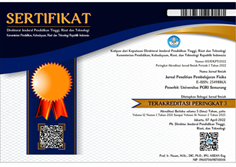Enhancing Bus Body Assembly Efficiency: Comparative Analysis of Ranked Positional Weight and Region Approach at PT. ABC
DOI:
https://doi.org/10.26877/asset.v6i4.675Keywords:
Assembly Line Optimization, Manufacturing Productivity, Efficiency Metrics, Workstation BalancingAbstract
In general line balancing problems occur in assembling industries compared to manufacturing industries. Problems that often occur on a production line can usually be seen from the presence of a high work in process bottleneck. The problem faced by the company in the production process is the level of efficiency of the workforce and production machines which are still less than optimal, due to the imbalance of the workload between work stations caused by delays in materials from the warehouse, then the operator usually waits for directions from the foreman first, then waits for the material processing process from other station. Therefore, in the bus body assembly process, it is necessary to make an analysis or calculation of the balance of the bus body assembly process so that it can run smoothly. In the line balancing study using the ranked positional weight and region approach methods, the results of the ranked positional weight method for the bus body assembly line efficiency were 78.43%, then for the balance delay of the bus body assembly 21.57% and idle time 1189.16 minutes. After data processing using the region approach method for the bus body assembly line efficiency, the results were 64.84%, then for the balance delay of the bus body assembly 35.16% and idle time 2344.75 minutes
References
Baroto, T. (2017). PERENCANAAN DAN PENGENDALIAN PRODUKSI.
Basalamah, M. R., Azizah, H. N., Kholifah, U., & Suroso, H. C. (2019). Implementation of Line Balancing in Taqwa Clothing Production Process at UD. Sofi Garment Department of Industrial Engineering, Faculty of Industrial Technology,. Journal of Industrial Engineering, 307–312.
Basuki, M., Aprilyanti, S., & Junaidi, M. (2019). Perancangan sistem keseimbangan lintasan produksi dengan pendekatan metode heuristik. Jurnal Tek, 11(2).
Dharmayanti, I. (2019). Jurnal Manajemen Industri dan Logistik PERHITUNGAN EFEKTIFITAS LINTASAN PRODUKSI. Jurnal Teknik Industri, 01, 43–54.
Dhede Pristi and others, ‘Designing Line Balance of Production Line / Assembly of Vise in Makassar City Using Manual and Software Line Balancing Methods’, Talenta Conference Series: Energy & Engineering (EE), 3.2 (2020), 180–85 .
Fardiansyah, I., & Tri, W. (2019). METODE LINE BALANCING PADA PROSES PENGEMASAN. 3(1), 57–62.
W. Gunawan and M. Wirawati, “Analisis Perbandingan Kriteria Line Balancing Dengan Menggunakan Metode Lcr Pada Automation Cell (Studi Kasus Di Pt. Unp),” J. Ind. Eng. Manag. Res., vol. 4, no. 4, pp. 95–107, 2023.
Hapid, Y., Studi, P., Industri, T., Teknik, F., Raya, U. S., Korespondensi, P., Kerja, B., Balancing, L., Weight, R. P., & Index, S. (2021). PLASTIC RECYCLING WITH RANKED POSITIONAL APPROACH. Journal of Industrial Management, 7(1), 65–72.
Indrani Dharmayanti and Hafif Marliansyah, ‘Journal of Industrial Management and Logistics CALCULATION OF PRODUCTION LINE EFFECTIVENESS’, Industrial Management and Logistics, 03.NO.01 (2019), 43–54.
Journal, R. T., Line, A., Untuk, B., Lintasan, E., Perakitan, P., Fitri, M., Adelino, M. I., Apuri, M. L., & Teknik, F. (2022). http://jurnal.umsb.ac.id/index.php/RANGTEKNIKJOURNAL. Jurnal Manajemen Industri, 5(2), 295–300.
Juwita, E., Suhardi. B., & Apriliana. F. (2019). Analisis Keseimbangan Lini Dan Usulan Perbaikan Menggunakan Metode Line Balancing Di Pt. XYZ. Jurnal Universitas Sebelas Maret.
Mahmud Basuki and others, ‘Design of Production Line Balance System Using Heuristic Method Approach’, Journal of Technology, 11.2 (2019), 1–9 .
Panudju, A. T., Panulisan, B. S., & Fajriati, E. (2019). ANALISIS PENERAPAN KONSEP PENYEIMBANGAN LINI ( LINE BALANCING ) DENGAN METODE RANKED POSITION WEIGHT ( RPW ) PADA SISTEM PRODUKSI PENYAMAKAN KULIT DI PT . TONG. Jurnal Tekni, 5(2).
Pristi, D. (2020). Merancang Keseimbangan Lintasan Produksi/Perakitan Ragum Pada Kota Makassar Menggunakan Metode Line Balancing Secara Manual dan Software. Jurnal Teknik Industri, 1–8.
Rachman, T., Aviantarisantoso, C., Studi, P., Industri, T., Teknik, F., Esa, U., & Jeruk, K. (2019). COMPARISON OF RANKED POSITIONAL WEIGHT (RPW) METHOD, LARGEST CANDIDATE RULE METHOD, AND J-WAGON METHOD FOR DETERMINING OPTIMAL TRAFFIC BALANCE MODEL SHOE SAMPLE PRODUCTION. Jurnal Tek, 1–9.
Setyawan, D., Pulansari, F., & Hayati, K. (2021). Analisa Line Balancing Menggunakan Metode Moodie Young Dan Ranked Positional Weight Di Cv. XYZ. Jurnal Manajemen Industri dan Teknologi. Vol. 2 No. 1
Sugiarto. (2017). Bahan Ajar Sistem Produksi.
Taufiqur Rachman and Crystal Aviantari Santoso, ‘Perbandingan Metode Ranked Positional Weight (RPW), Metode Largest Candidate Rule, Dan Metode J Wagon Untuk Penentuan Keseimbangan Lintasan Optimal Produksi Sampel Sepatu Model SSOW’, Inovisi, 15.1 (2019).
Wiky Sabardi and others, ‘Production Line Efficiency Design Using the Helgeson-Birnie Method (Ranked Positional Weight) to Increase Production Capacity (Case Study on Production Unit I Shift I PT. SUMBETRI MEGAH)’, JURUTERA - Jurnal Umum Teknik Terapan, 8.02 (2021), 26–37
Valentina, F., & Widyo, P. (2022). Penerapan Line Balancing pada PT . XYZ dengan Metode Largest Candidate Rul e dan Ranked Positional Weight. Jurnal Manajemen In, 1–10. [13] Dhede Pristi and others, ‘Designing Line Balance of Production Line / Assembly of Vise in Makassar City Using Manual and Software Line Balancing Methods’, Talenta Conference Series: Energy & Engineering (EE), 3.2 (2020), 180–85 .
Wirabhuana, A., & Fadhira, T. (2007). Bahan Ajar Sistem Produksi.











